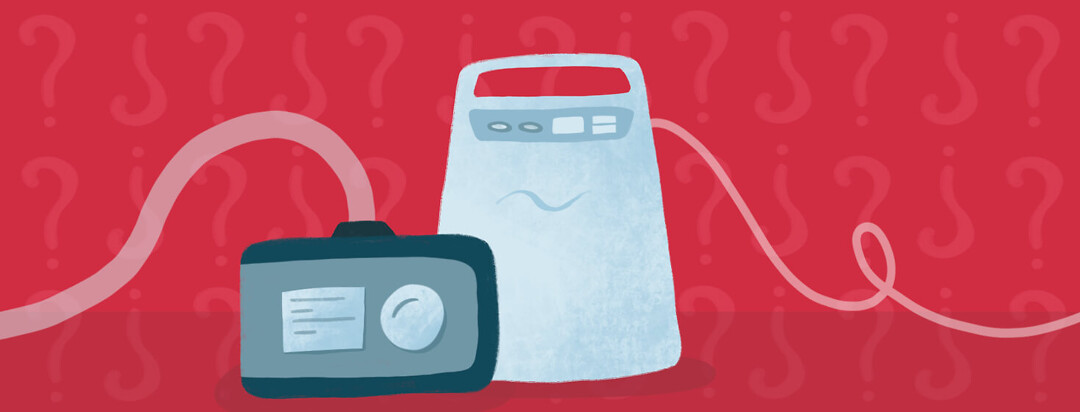What Is the Difference Between CPAP Therapy and Oxygen Therapy?
If you or your partner has sleep apnea, you know that snoring, choking, and pauses in breathing can severely disrupt sleep. However, these problems can lead to much more than the loss of a good night’s sleep.
Obstructive sleep apnea (OSA) is the most common form of sleep apnea. In OSA, the airways collapse during sleep. Blockage of the airway leads to the classic snoring, choking, and pausing common with OSA. When the airways are blocked, oxygen from the lungs cannot get to the cells and organs in the body. The result is low blood oxygen levels, known as hypoxemia.1
Low blood oxygen can lead to many problems in the body, including issues with the brain, heart, and lungs. To help prevent this complication, doctors prescribe different therapies to increase oxygen levels for those with sleep apnea.1
Two devices – CPAP machines and oxygen concentrators – help to improve oxygen levels in the blood. While similar in some ways, these devices work in different ways to help treat sleep apnea. Knowing what these machines are, the differences between the machines, and when these are used will help you better understand the ways oxygen levels can be improved with sleep apnea.2,3
What is CPAP therapy?
Continuous positive airway pressure (CPAP) machines are commonly used to treat sleep apnea. CPAP helps keep the airways open by blowing pressurized air through a mask worn while sleeping. Keeping the airways open helps decrease the chances of paused breathing while sleeping, which occurs in sleep apnea.4
Using a CPAP machine helps to prevent snoring and choking while sleeping. Because CPAP opens the airways, breathing improves, and oxygen inside the body increases. Because CPAP decreases choking and snoring while increasing oxygen levels, it helps those with sleep apnea sleep through the night.4
There are many different kinds of CPAP devices with different masks and nose pieces. When you begin using a CPAP device, you will be measured for the proper fit of the CPAP mask.4
What is an oxygen concentrator?
An oxygen concentrator is another device that a doctor might prescribe to help increase blood oxygen levels for those with sleep apnea. An oxygen concentrator pulls air from the room and removes nitrogen. What is left over is oxygen, which can be used for oxygen therapy.5
Concentrators are different from oxygen tanks because concentrators use electrical pumps to filter the air and provide a continuous supply of oxygen. While oxygen concentrators may be found online, the U.S. Food and Drug Administration (FDA) has not approved oxygen concentrators to be sold without a doctor’s prescription.5
There are safety considerations with concentrators to keep in mind:5
- Do not smoke or have an open flame while using the concentrator or any oxygen product.
- Do not block the vents of the concentrator as this can impair its function.
- Check the device on occasion to make sure the alarms and amount of oxygen are correct.
- Do not change the oxygen levels. Improper oxygen delivery can be life-threatening. Talk to your doctor before making any changes.
What are the differences between CPAP and oxygen concentrators?
While both CPAP and oxygen concentrators can be used to treat sleep apnea, there are important differences between these devices:3-5
- Oxygen concentrators create oxygen from the air, while CPAP machines do not
- CPAP machines blow positive pressure through a mask in order to keep the airways open. Oxygen concentrators do not have positive pressure and do not work to keep the airways open.
- Your doctor may or may not prescribe both devices together. Many times, CPAP devices work effectively to increase blood oxygen levels for those with sleep apnea. If CPAP alone is not enough, you may need oxygen therapy.
Talk to your doctor about your symptoms and questions you have about your current therapy. Oxygen therapy alone, CPAP, or a combination of both might be a good option for you. Oxygen therapy needs to be used exactly as it is prescribed in order to prevent complications.
If you are new to oxygen therapy or CPAP, make sure your doctor goes over the equipment in detail to ensure you know the ins and outs of the devices. CPAP and oxygen therapy are lifestyle changes that will require adjustment. Understanding how these therapies work and their risks and benefits will help you adjust to living with these devices.

Join the conversation